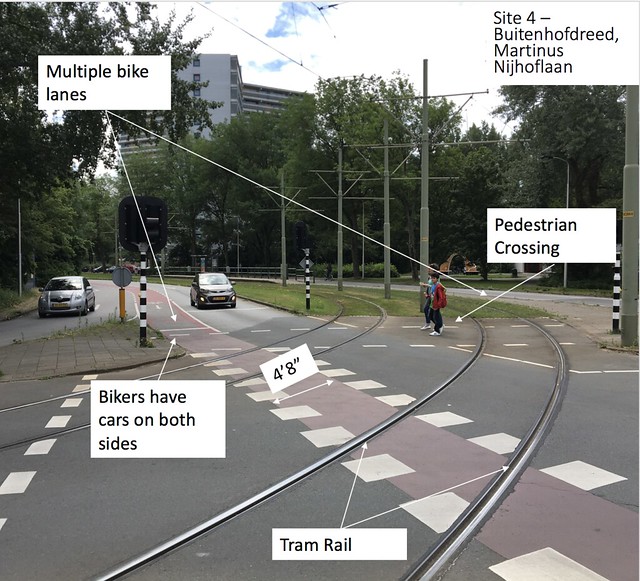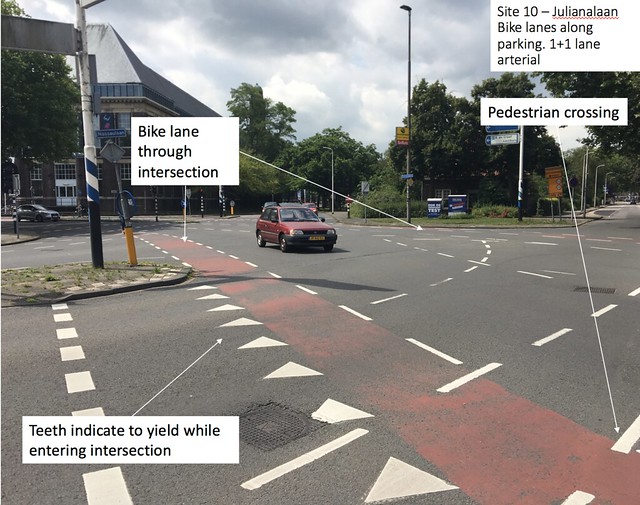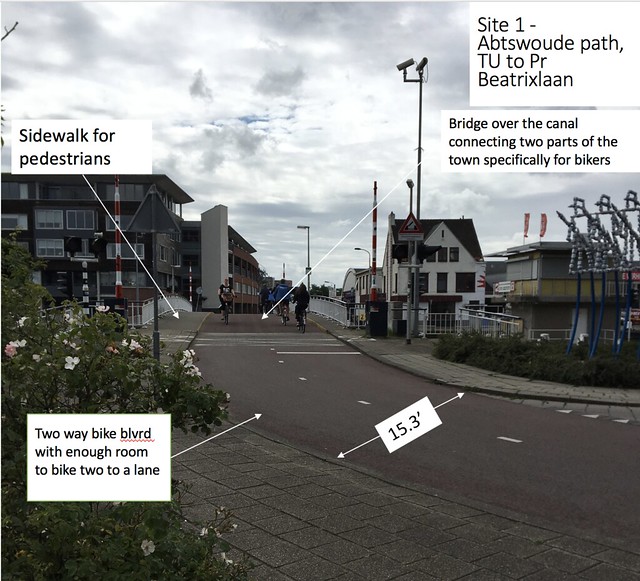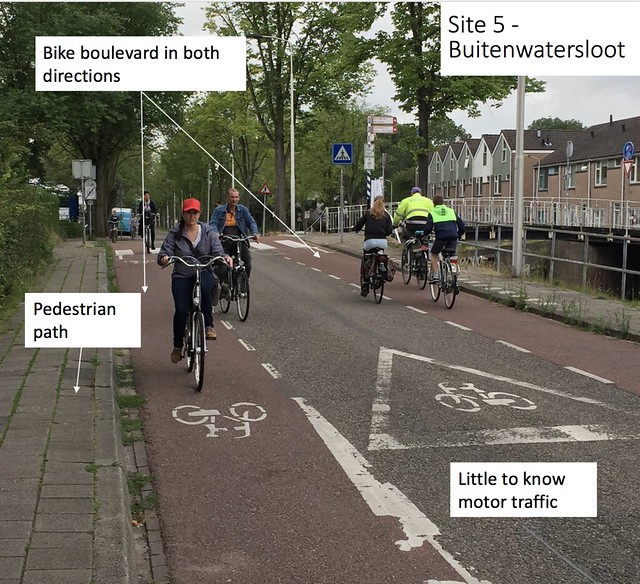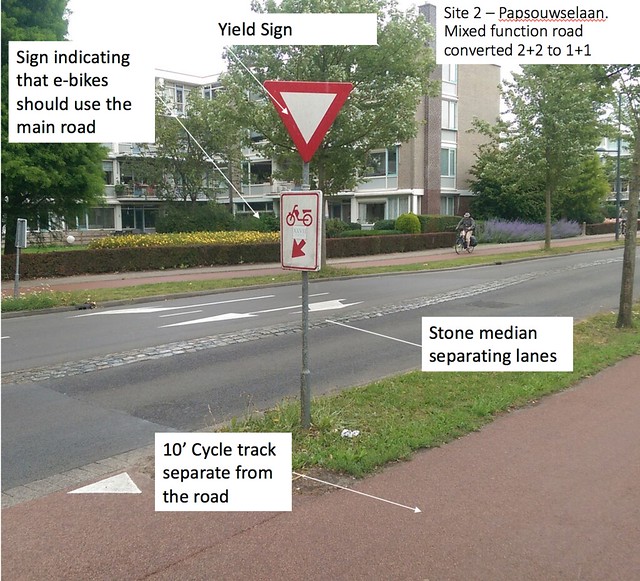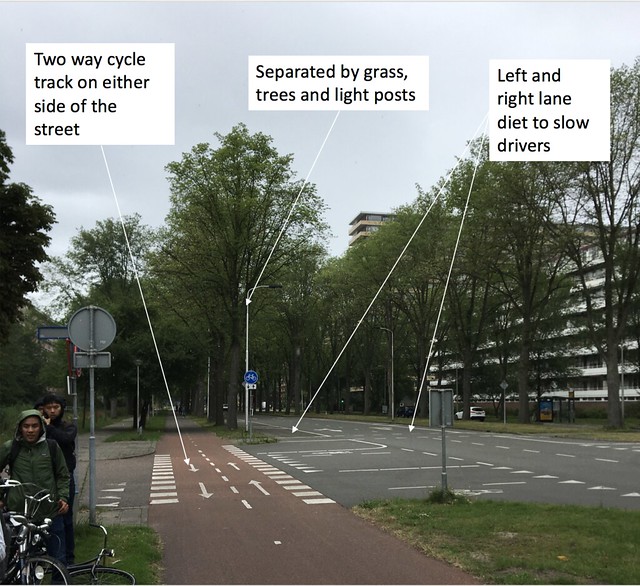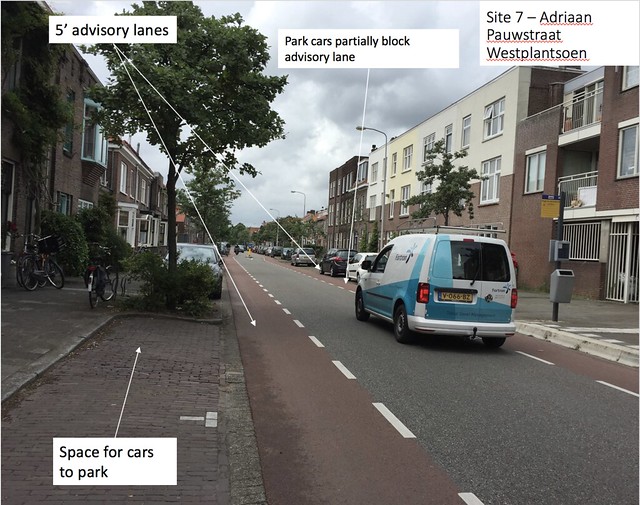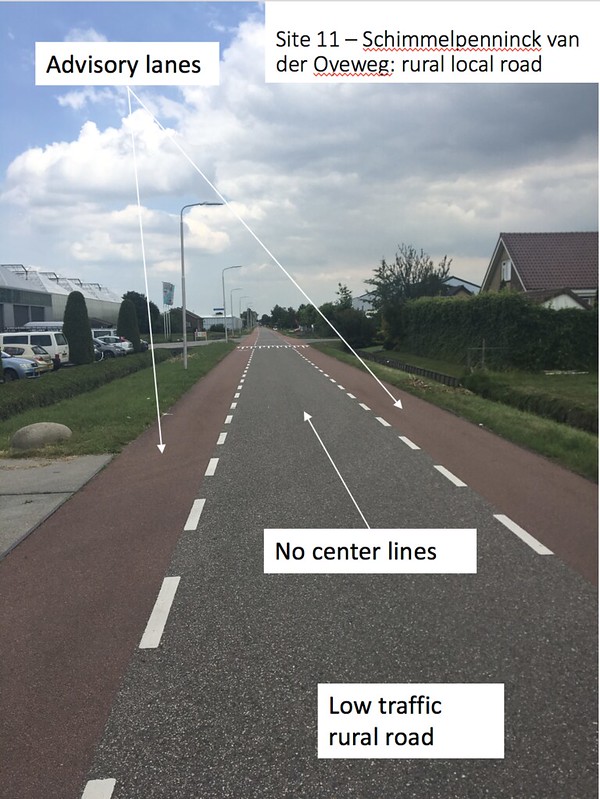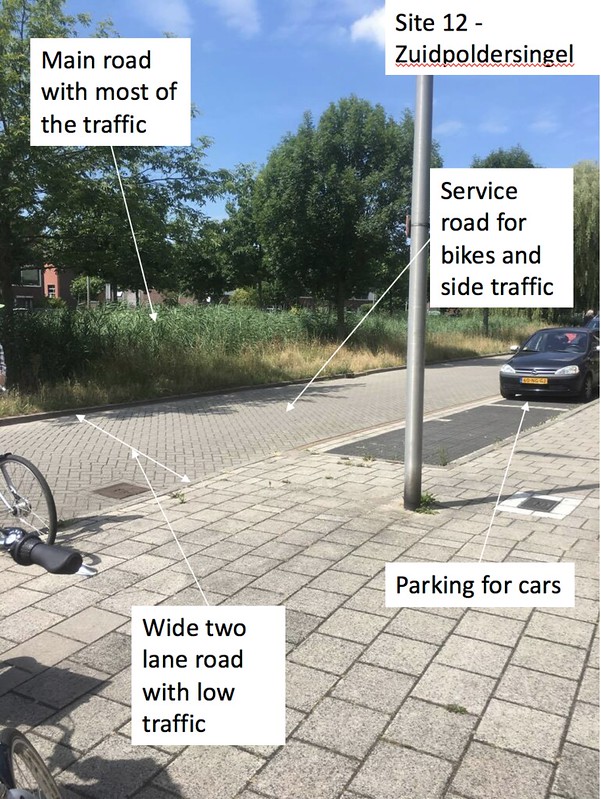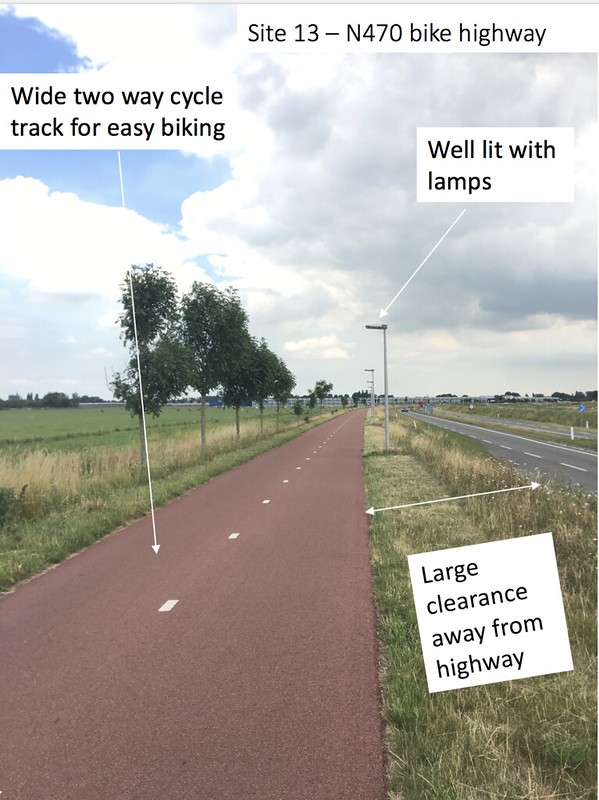Assignment #4: Biking Facilities in Delft
Over the past two days, we visited twelve sites that highlighted Dutch biking infrastructure. Each site we visited showed us a specific example of a biking facility that the Dutch use to increase that ease of day to day biking.
Bike Lanes
Bike lanes are one of the easiest and cheapest ways to integrate biking infrastructure into roads. It consists of a separate lane normally indicated by a dashed line and red pavement. Bikers still share the road with cars, however, they have a designated area in which they can bike. However, bike lanes are not the safest biking facility and the proximity to motor vehicles can cause bikers stress on their daily commute. If there are parked cars next to the biking lane, riders have the risk of being doored and seriously hurt. The first site that we visited that used bike lanes was Buitenhofdreed, Martinus Nijhoflaan (site 4). This site was a complicated intersection that involved cars, bikes, pedestrians, and a tram. To make a right turn, bikers are forced to ride alongside cars on each side which decreases the rider’s safety and increases their stress. The bike lane is only 4’8” which is not very comfortable for bikers to ride on. The intersection forces cars to yield to both pedestrians and bikers which slows down the speed in which they can pass through the intersection. Pedestrians do not have cross walks on each street forcing them to cut through a patch of grass which can lead to an accident. Overall, the intersection’s dated infrastructure could be improved, however, it still allows bikers to travel with relative ease. The next two stops that demonstrated bike lanes were Nassaulaan and Julianalaan (site 9 and 10). Nassaulaan’s bike lane curved behind the bus stop to reduce the risk of a collision when the passengers exit the bus. However, the bike lanes disappear by the school and the road turns to brick to slow down drivers. This can be confusing to bikers who now must share the road with cars. Cars are also parked on the right which can put bikers at a risk of being doored. Julianalaan puts the biker at risk due to the amount of traffic in the intersection. Bikers must bike alongside traffic and yield for cars, other bikes, and pedestrians. Overall, Julianalaanm and Nassaulaamn were quite stressful to bike on given the high amount of traffic.
Bike Boulevard
Bike boulevards are an easy and cheap way to allow bike friendly traffic flow on streets that have been fully or partially closed to motor traffic. Biking on bike boulevards allow many bikers to take advantage of the road without the stress of other cars. The first boulevard that we saw was the Abtswoude path which made a connection from TU to the other side of the canal. This bike boulevard allows many students a safe path to cross the canal and then return to school. The path has two large lanes which take up 15.3 feet overall. This is more than enough room for bikers to bike comfortably side by side. The other bike boulevard that we visited was Buitenhofdreed, Martinus Nijhoflaan (site 5), which was also a road that was partially shut down to motor traffic to allow a safe road for bikers to travel on. These boulevards are an effective way to move large amounts of bikers through Delft. They are given the room to safely travel from A to B without the stress of motor traffic.
Cycle Tracks
Cycle tracks are one of the safest and more progressive types of bike facilities because they are separate from the street containing motor traffic. These tracks allow bikers to travel with relatively low stress and they reduce the risk of bikers getting hit by a car. Engineers can use parked cars, a greenway, concrete, or even light posts to create a protective barrier between the bike lane and motor traffic. Cycle tracks can often be more expensive and difficult to build than other bike facilities, however, they leave bikers extremely protected and cause very low stress to cyclists using the track. Papsouwselaan (site 2) was originally a 2+2 road that was converted to a 1+1 with a cycle path. This road diet forces cars to drive slower while also creating a safe, protected path for bikers to use. The road has a stone median in the center creating a narrower lane for cars and therefore again causing them to slow down. This new design allows easier crossings for pedestrians and decreases the risk of bike and car accidents. The road then leads into a bike roundabout outside of the car roundabout. To allow proper vision and eye contact left turns should be no smaller than 90 degrees. In the roundabout, the left turn is less than 90 degrees adding some risk to bikers merging into the cycle track. Voorhofdreed (site 3) is another example of a road with a two-way bike lane that gives bikers total protection from cars. The road originally had a left and right turn lane for cars, however, they were removed to prevent cars from speeding. The road diet is another example of how narrower roads force cars to drive slower and more cautiously. Ruys de Beerenbrouckstraat (site 8) is the last road that we visited and was recently redesigned to a 1+1 road with a cycle track. The street previously was very wide with bike lanes, however, the city redesigned the road to decrease the cars speed. They could remove two stop lights and make it easier for pedestrians to cross by converting it into a 1+1 road. They also raised the crossing intersection and paved it with red brick to make it clear to drivers that they need to lower their speeds. The cycle track allows easy access to the grocery store and again increases the safety of bikers and pedestrians.
Advisory Lanes
Advisory lanes are a good bike facility option on low traffic streets that are too narrow to add traditional bike lanes. Two dotted lines are added on either side of the street to indicate where the bikers should ride, and the car simply drives in the middle. If there is another car on the street, they have the option to use the bike lanes to pass the other car. This alternative allows cars enough space to drive comfortably while still giving cyclists a clear path to ride on. Hugo de Grootstraat (site 6) is an example of an advisory lane in front of a school. When traffic increases, cars can temporarily use the bike lanes to avoid other bikes and cars. However, when traffic gets too congested, parked cars can cause a hazard for cyclists who may have to dodge traffic that are in their advisory lane. Adriaan Pauwstraat (site 7) also has advisory lanes as well as space for cars to park without blocking the cyclist’s lane. Schimmelpenninck van der Oyeweg (site 11) is the last advisory road that we visited. The narrow and low-traffic rural road makes it an ideal place to put advisory lanes. Bikes can cycle freely and if a truck comes alone, they can make use of the advisory lane on the opposite side of the road.
Service Road
Some main roads have service roads which are parallel to a main road. These motorways are used for some local traffic and mostly bikers who can bike without the traffic from main roads. Cars only use the service road for a few meters as they unload or bike by their homes. Utilizing these roads for bikers is a cheap alternative to cycle tracks and can allow bikers to travel along main roads with little stress. The service road that we visited Zuidpoldersinger and was along a main road leading outside of Delft. It allows bikers who need a fast route out of the city to follow a main road while staying out of the traffic. This safe alternative is cheap to allow bikes to use if the road is already, however, service roads are also beneficial for local traffic and trucks.
Bicycle Highway
Bicycle highways are ideal when biking long distances especially between towns. They are long stretches, normally two ways, that only accommodate bikers. These highways are normally put next to motor freeways and are well lit for commuters who travel during the dark hours of the day. We visited the N470 bicycle highway that connects Delft to the neighboring town. Bikes can ride a very long distance to the next town without any interference from pedestrians or cars. These safe havens for cyclists can often be very expensive since it consists of a very long cycle track. While we were riding back to town, we visited an underpass built specifically for cyclists which allows them to go under the motor freeway. This multi-million-euro project is certainly expensive; however, it allows bikers to travel under the highway rather than trying to cross it.

